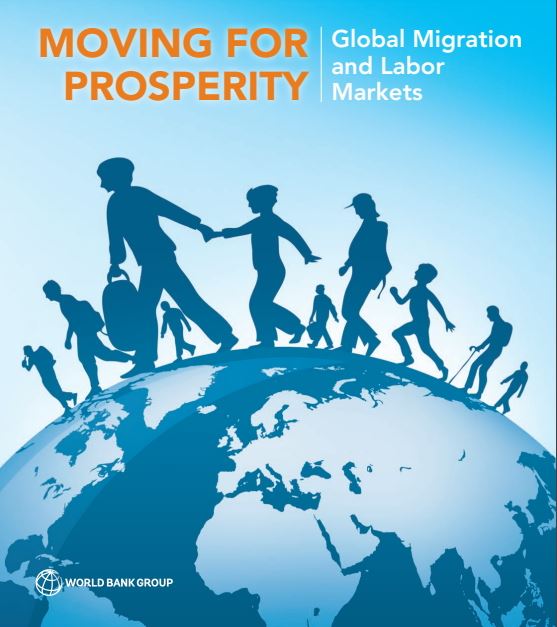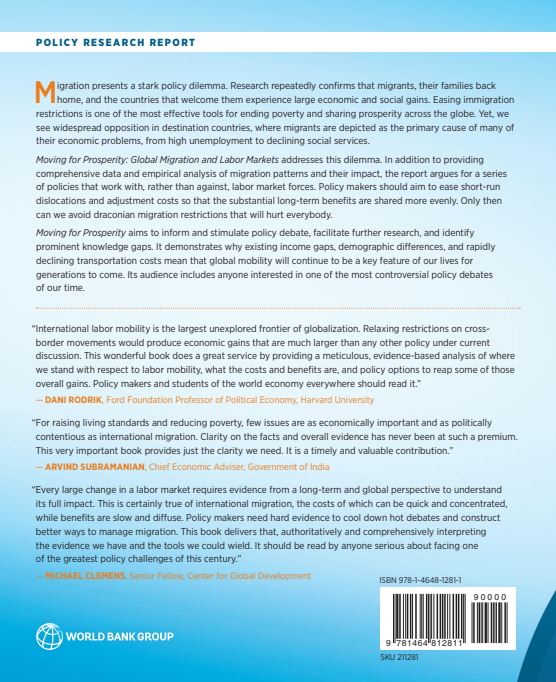 세계은행이 펴낸 정책보고서 「번영을 위한 이주 : 국제이주와 노동시장」 표지
세계은행이 펴낸 정책보고서 「번영을 위한 이주 : 국제이주와 노동시장」 표지
Contents
Foreword xi
Acknowledgments xiii
About the Team xv
Abbreviations xvii
Overview 1
The patterns of global migration: Scale 4
The patterns of global migration: Concentration 6
The determinants of migration 9
The short-term impact of immigration: Labor markets 15
Addressing short-term costs: Assistance and adjustment policies 19
The long-term impact: Immigrant integration and assimilation 22
High-skilled migration, agglomeration, and brain drain 27
International coordination of migration policy 35
Final thoughts 36
Notes 37
References 37
1. Patterns of Global Migration 39
Overall migration patterns 40
The concentration of economic migrants 51
Internal migration 57
Refugees 61
Migrant demographics 69
Notes 83
References 83
2. The Economic Drivers of Migration Decisions 85
Why migrate? The benefits of migrating 86
Why migrate? The costs of migrating 100
Why migrate? A cost–benefit analysis 116
Who chooses to migrate? Skill composition and the selection
of migrants 125
Annex 2A Gravity models 135
Notes 137
References 140
3. The Wage and Employment Impacts of Migration 145
Conceptual issues: The factor proportions approach 146
Empirical challenges: Immigrants and natives choose where to
live and work 149
Measurement challenges: Skill “downgrading” and
the undocumented 152
Empirical strategy I: The national skill cell approach 156
Empirical strategy II: The local labor market approach 161
Empirical strategy III: Natural experiments 164
Emigration and labor markets 173
Annex 3A Methodological challenges in the
immigration literature 175
Notes 180
References 182
4. Longer-Term Dynamics: Immigrant Economic Adjustment
and Native Responses 189
Economic integration of immigrants and refugees 191
Return and onward migration 209
Native responses to immigration 215
Notes 224
References 225
5. High-Skilled Migration 233
Defining a high-skilled migrant 235
Patterns of high-skilled migration 238
Determinants of high-skilled migration patterns 247
Impact of high-skilled migration on origin countries 254
Effects of skilled migration on destination countries 261
High-skilled migration policies 266
Note 272
References 273
서문
이민이 내 이야기를 가능하게 했다. 저는 제 미래가 제 나라의 경계 안에서 결정되는 것처럼 보였던 시기에 불가리아에서 태어났다. 하지만 철의 장막이 무너지면서 해외여행과 유학, 일을 할 수 있는 기회가 생겼고, 결국 미국으로 건너가 현재 대표이사를 맡고 있다.
연구는 이주가 이민자뿐만 아니라 그들이 남겨둔 지역사회와 그들을 환영하는 국가에도 좋다는 것을 반복적으로 보여주었다. 노동력 이동을 완화하는 정책만큼 극심한 빈곤을 끝내고 번영을 공유한다는 우리의 목표를 달성하는 데 많은 역할을 하는 경제 정책은 거의 없다.
정책 입안자들에게, 이주는 딜레마를 나타낸다. 한편으로, 이민은 수백만 명의 사람들이 자신과 가족을 위해 더 나은 삶을 만들도록 돕는다. 일부 사람들에게, 그것은 가난, 폭력, 그리고 갈등에서 벗어날 수 있는 그들의 유일한 희망이다.
반면, 목적지 국가에서는 이주에 대한 저항이 상당하다. 이민자들은 종종 높은 실업률, 범죄, 그리고 열악한 사회 서비스의 원인들 중 하나로 묘사된다. 이민자들의 희망과 난민들은 다리보다는 장벽을 만들어야 한다는 요구에 의해 점점 더 위협받고 있다.
이 책은 이민에 대한 보다 균형 잡힌 시각을 장려하여 정책 입안자들이 모두를 위해 이 현상의 이점을 활용하는 방법을 고심하는 동안 새로운 분석과 포괄적인 데이터를 제공한다. 비록 이민이 목적지 국가에 큰 전반적인 혜택을 제공하지만, 지역 주민들은 종종 부정적인 영향을 느낀다. 이주민들은 물결을 타고 도착하는 경향이 있고, 강한 경제적 힘 때문에 특정 지역, 부문 또는 직업에 상륙한다. 그 결과, 그 지역의 사람들은 일자리를 찾기 위해 국가의 다른 지역이나 다른 직업으로 이동하면서 상당한 영향을 느낀다.
정책은 시민과 이민자 모두가 장기적인 혜택을 경험하고 공유할 수 있도록 이러한 전환을 관리하는 데 중점을 두어야 한다. 이것은 이민 패턴의 급격한 정점을 완화하고, 일시적이지만 종종 고통스러운 경제적 부담과 혼란으로부터 시민을 보호하는 것을 의미한다.
나는 이 책에서 제공된 분석이 이민에 대한 대화의 변화를 촉진할 수 있기를 바란다. 계속수익 및 기회 격차, 인구통계학적 프로필의 차이, 그리고 세계의 가난하고 취약한 사람들의 열망의 증가는 이주가 가까운 미래에 세계의 기본적인 모습이 되리라는 것을 의미한다.
가까운 장래에 세계의 근본적인 특징 우리는 이제 모든 세대의 사람들에게 경제적, 사회적 이익을 제공할 수 있는 지속 가능한 이주 체제를 만들기 위해 함께 행동해야 한다.
크리스티나 게오르기예바
최고 경영자 / 세계은행
Foreword
Migration made my story possible. I was born in Bulgaria at a time when my future seemed defined within the boundaries of my country. But, with the fall of the iron curtain, I got a chance to travel, study, and work abroad, and eventually moved to the United States to work at the institution of which I am now the CEO.
Research has repeatedly demonstrated that migration is good not just for migrants, but also for the communities they leave behind and for the countries that welcome them. Few economic policies do as much to achieve our goals of ending extreme poverty and sharing prosperity as those that ease labor mobility.
For policy makers, migration represents a dilemma. On the one hand, migration helps millions create a better life for themselves and their families. For some, it is their only hope of escaping poverty, violence, and conflict.
On the other hand, there is considerable resistance to migration in destination countries. Migrants are often portrayed as one of the causes of high unemployment, crime, and poor social services. The hopes of migrants and refugees are increasingly threatened by calls for creating barriers, rather than bridges.
This book encourages a more balanced view of migration, providing fresh analysis and comprehensive data for policy makers as they grapple with how to harness the benefits of this phenomenon for all. Although migration provides large overall benefits to the destination country, local populations often feel the negative effects. Migrants tend to arrive in waves, and they land in certain areas, sectors, or occupations because of strong economic forces. As a result, people in those locations feel a significant impact, moving either to other parts of the country or to other jobs to find employment.
Policies should focus on managing these transitions so that both citizens and migrants can experience and share in the long-term benefits. This means smoothing the sharp peaks of migration patterns, as well as protecting citizens from transitory but often painful economic burdens and dislocations.
It is my hope that the analysis provided in this book can facilitate a change in the conversation about migration. Continued income and opportunity gaps, differences in demographic profiles, and rising aspirations of the world’s poor and vulnerable all mean that migration will be a fundamental feature of the world for the foreseeable future.
We must act together now to create sustainable migration regimes that can deliver economic and social gains for everyone in the generations to come.
Kristalina Georgieva
Chief Executive Officer
World Bank
[※ World Bank. 2018. Moving for Prosperity: Global Migration and Labor Markets. Policy Research Report. Washington, DC: World Bank. doi:10.1596/978-1-4648-1281-1. License: Creative Commons Attribution CC BY 3.0 IGO
This translation was not created by The World Bank and should not be considered an official World Bank translation. The World Bank shall not be liable for any content or error in this translation.
This is an adaptation of an original work by The World Bank. Views and opinions expressed in the adaptation are the sole responsibility of the author or authors of the adaptation and are not endorsed by The World Bank.]
 세계은행이 펴낸 정책보고서 「번영을 위한 이주 : 국제이주와 노동시장」 뒷표지
세계은행이 펴낸 정책보고서 「번영을 위한 이주 : 국제이주와 노동시장」 뒷표지
<pinepines@injurytime.kr>
저작권자 ⓒ 인저리타임, 무단 전재 및 재배포 금지